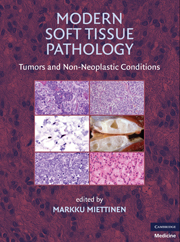Book contents
- Frontmatter
- Contents
- CONTRIBUTORS
- PREFACE
- Chap 1 OVERVIEW OF SOFT TISSUE TUMORS
- Chap 2 RADIOLOGIC EVALUATION OF SOFT TISSUE TUMORS
- Chap 3 IMMUNOHISTOCHEMISTRY OF SOFT TISSUE TUMORS
- Chap 4 GENETICS OF SOFT TISSUE TUMORS
- Chap 5 MOLECULAR GENETICS OF SOFT TISSUE TUMORS
- Chap 6 FIBROBLAST BIOLOGY, FASCIITIS, RETROPERITONEAL FIBROSIS, AND KELOIDS
- Chap 7 FIBROMAS AND BENIGN FIBROUS HISTIOCYTOMAS
- Chap 8 FIBROMATOSES
- Chap 9 BENIGN FIBROBLASTIC AND MYOFIBROBLASTIC PROLIFERATIONS IN CHILDREN
- Chap 10 CHILDHOOD FIBROBLASTIC AND MYOFIBROBLASTIC PROLIFERATIONS OF VARIABLE BIOLOGIC POTENTIAL
- Chap 11 MYXOMAS AND OSSIFYING FIBROMYXOID TUMOR
- Chap 12 SOLITARY FIBROUS TUMOR, HEMANGIOPERICYTOMA, AND RELATED TUMORS
- Chap 13 FIBROBLASTIC AND MYOFIBROBLASTIC NEOPLASMS WITH MALIGNANT POTENTIAL
- Chap 14 LIPOMA VARIANTS AND CONDITIONS SIMULATING LIPOMATOUS TUMORS
- Chap 15 ATYPICAL LIPOMATOUS TUMOR AND LIPOSARCOMAS
- Chap 16 SMOOTH MUSCLE TUMORS
- Chap 17 GASTROINTESTINAL STROMAL TUMOR
- Chap 18 STROMAL TUMORS AND TUMOR-LIKE LESIONS OF THE FEMALE GENITAL TRACT
- Chap 19 ANGIOMYOLIPOMA AND RELATED TUMORS (PERIVASCULAR EPITHELIOID CELL TUMORS)
- Chap 20 RHABDOMYOMAS AND RHABDOMYOSARCOMAS
- Chap 21 HEMANGIOMAS, LYMPHANGIOMAS, AND REACTIVE VASCULAR PROLIFERATIONS
- Chap 22 HEMANGIOENDOTHELIOMAS, ANGIOSARCOMAS, AND KAPOSI'S SARCOMA
- Chap 23 GLOMUS TUMOR, SINONASAL HEMANGIOPERICYTOMA, AND MYOPERICYTOMA
- Chap 24 NERVE SHEATH TUMORS
- Chap 25 NEUROECTODERMAL TUMORS: MELANOCYTIC, GLIAL, AND MENINGEAL NEOPLASMS
- Chap 26 PARAGANGLIOMAS
- Chap 27 PRIMARY SOFT TISSUE TUMORS WITH EPITHELIAL DIFFERENTIATION
- Chap 28 MALIGNANT MESOTHELIOMA AND OTHER MESOTHELIAL PROLIFERATIONS
- Chap 29 MERKEL CELL CARCINOMA AND METASTATIC AND SARCOMATOID CARCINOMAS INVOLVING SOFT TISSUE
- Chap 30 CARTILAGE- AND BONE-FORMING TUMORS AND TUMOR-LIKE LESIONS
- Chap 31 SMALL ROUND CELL TUMORS
- Chap 32 ALVEOLAR SOFT PART SARCOMA
- Chap 33 PATHOLOGY OF SYNOVIA AND TENDONS
- Chap 34 MISCELLANEOUS TUMOR-LIKE LESIONS, AND HISTIOCYTIC AND FOREIGN BODY REACTIONS
- Chap 35 LYMPHOID, MYELOID, HISTIOCYTIC, AND DENDRITIC CELL PROLIFERATIONS IN SOFT TISSUES
- Chap 36 CYTOLOGY OF SOFT TISSUE LESIONS
- Chap 37 SURGICAL MANAGEMENT OF SOFT TISSUE SARCOMA: HISTOLOGIC TYPE AND GRADE GUIDE SURGICAL PLANNING AND INTEGRATION OF MULTIMODALITY THERAPY
- Chap 38 MEDICAL ONCOLOGY OF SOFT TISSUE SARCOMAS
- Index
- References
Chap 1 - OVERVIEW OF SOFT TISSUE TUMORS
Published online by Cambridge University Press: 01 March 2011
- Frontmatter
- Contents
- CONTRIBUTORS
- PREFACE
- Chap 1 OVERVIEW OF SOFT TISSUE TUMORS
- Chap 2 RADIOLOGIC EVALUATION OF SOFT TISSUE TUMORS
- Chap 3 IMMUNOHISTOCHEMISTRY OF SOFT TISSUE TUMORS
- Chap 4 GENETICS OF SOFT TISSUE TUMORS
- Chap 5 MOLECULAR GENETICS OF SOFT TISSUE TUMORS
- Chap 6 FIBROBLAST BIOLOGY, FASCIITIS, RETROPERITONEAL FIBROSIS, AND KELOIDS
- Chap 7 FIBROMAS AND BENIGN FIBROUS HISTIOCYTOMAS
- Chap 8 FIBROMATOSES
- Chap 9 BENIGN FIBROBLASTIC AND MYOFIBROBLASTIC PROLIFERATIONS IN CHILDREN
- Chap 10 CHILDHOOD FIBROBLASTIC AND MYOFIBROBLASTIC PROLIFERATIONS OF VARIABLE BIOLOGIC POTENTIAL
- Chap 11 MYXOMAS AND OSSIFYING FIBROMYXOID TUMOR
- Chap 12 SOLITARY FIBROUS TUMOR, HEMANGIOPERICYTOMA, AND RELATED TUMORS
- Chap 13 FIBROBLASTIC AND MYOFIBROBLASTIC NEOPLASMS WITH MALIGNANT POTENTIAL
- Chap 14 LIPOMA VARIANTS AND CONDITIONS SIMULATING LIPOMATOUS TUMORS
- Chap 15 ATYPICAL LIPOMATOUS TUMOR AND LIPOSARCOMAS
- Chap 16 SMOOTH MUSCLE TUMORS
- Chap 17 GASTROINTESTINAL STROMAL TUMOR
- Chap 18 STROMAL TUMORS AND TUMOR-LIKE LESIONS OF THE FEMALE GENITAL TRACT
- Chap 19 ANGIOMYOLIPOMA AND RELATED TUMORS (PERIVASCULAR EPITHELIOID CELL TUMORS)
- Chap 20 RHABDOMYOMAS AND RHABDOMYOSARCOMAS
- Chap 21 HEMANGIOMAS, LYMPHANGIOMAS, AND REACTIVE VASCULAR PROLIFERATIONS
- Chap 22 HEMANGIOENDOTHELIOMAS, ANGIOSARCOMAS, AND KAPOSI'S SARCOMA
- Chap 23 GLOMUS TUMOR, SINONASAL HEMANGIOPERICYTOMA, AND MYOPERICYTOMA
- Chap 24 NERVE SHEATH TUMORS
- Chap 25 NEUROECTODERMAL TUMORS: MELANOCYTIC, GLIAL, AND MENINGEAL NEOPLASMS
- Chap 26 PARAGANGLIOMAS
- Chap 27 PRIMARY SOFT TISSUE TUMORS WITH EPITHELIAL DIFFERENTIATION
- Chap 28 MALIGNANT MESOTHELIOMA AND OTHER MESOTHELIAL PROLIFERATIONS
- Chap 29 MERKEL CELL CARCINOMA AND METASTATIC AND SARCOMATOID CARCINOMAS INVOLVING SOFT TISSUE
- Chap 30 CARTILAGE- AND BONE-FORMING TUMORS AND TUMOR-LIKE LESIONS
- Chap 31 SMALL ROUND CELL TUMORS
- Chap 32 ALVEOLAR SOFT PART SARCOMA
- Chap 33 PATHOLOGY OF SYNOVIA AND TENDONS
- Chap 34 MISCELLANEOUS TUMOR-LIKE LESIONS, AND HISTIOCYTIC AND FOREIGN BODY REACTIONS
- Chap 35 LYMPHOID, MYELOID, HISTIOCYTIC, AND DENDRITIC CELL PROLIFERATIONS IN SOFT TISSUES
- Chap 36 CYTOLOGY OF SOFT TISSUE LESIONS
- Chap 37 SURGICAL MANAGEMENT OF SOFT TISSUE SARCOMA: HISTOLOGIC TYPE AND GRADE GUIDE SURGICAL PLANNING AND INTEGRATION OF MULTIMODALITY THERAPY
- Chap 38 MEDICAL ONCOLOGY OF SOFT TISSUE SARCOMAS
- Index
- References
Summary
DEFINITION
Soft tissue tumors are generally defined as tumors of connective tissues, including nonosseous sarcomas, benign mesenchymal tumors, and tumor-like proliferations. These tumors are usually considered to include non-osseous tumors of the extremities, trunk wall, intraabdominal and intrathoracic space, and head and neck, although definitions vary. Generally excluded from this definition are nonmesenchymal tumors of the skin, cutaneous melanoma, most primary epithelial tumors, and brain and bone tumors.
In this book, soft tissue is understood broadly to include any important tumors of nonbony tissues of the extremities, trunk wall, retroperitoneum, mediastinum, and head and neck, except organ-specific tumors. Gastrointestinal stromal tumors are included because of their clinical importance and common occurrence as metastatic abdominal masses. Cutaneous nevi and primary cutaneous melanoma and intracranial nerve sheath tumors have been excluded. Metastatic epithelial tumors and metastatic melanoma are included because of their practical importance (Table 1.1). As a subspecialty, soft tissue pathology intersects many other subspecialties of pathology.
CLASSIFICATION
The purpose of classification is to group similar tumors to create an understanding of tumor biology and behavior for developing treatment and follow-up strategies. The study of properly classified tumors also aids in the discovery of pathogenesis, devising biology-based treatments, and perhaps preventing tumors.
Soft tissue tumors continue to be classified according to the cell type that they resemble or have been thought to resemble.
- Type
- Chapter
- Information
- Modern Soft Tissue PathologyTumors and Non-Neoplastic Conditions, pp. 1 - 10Publisher: Cambridge University PressPrint publication year: 2010
References
- 1
- Cited by



